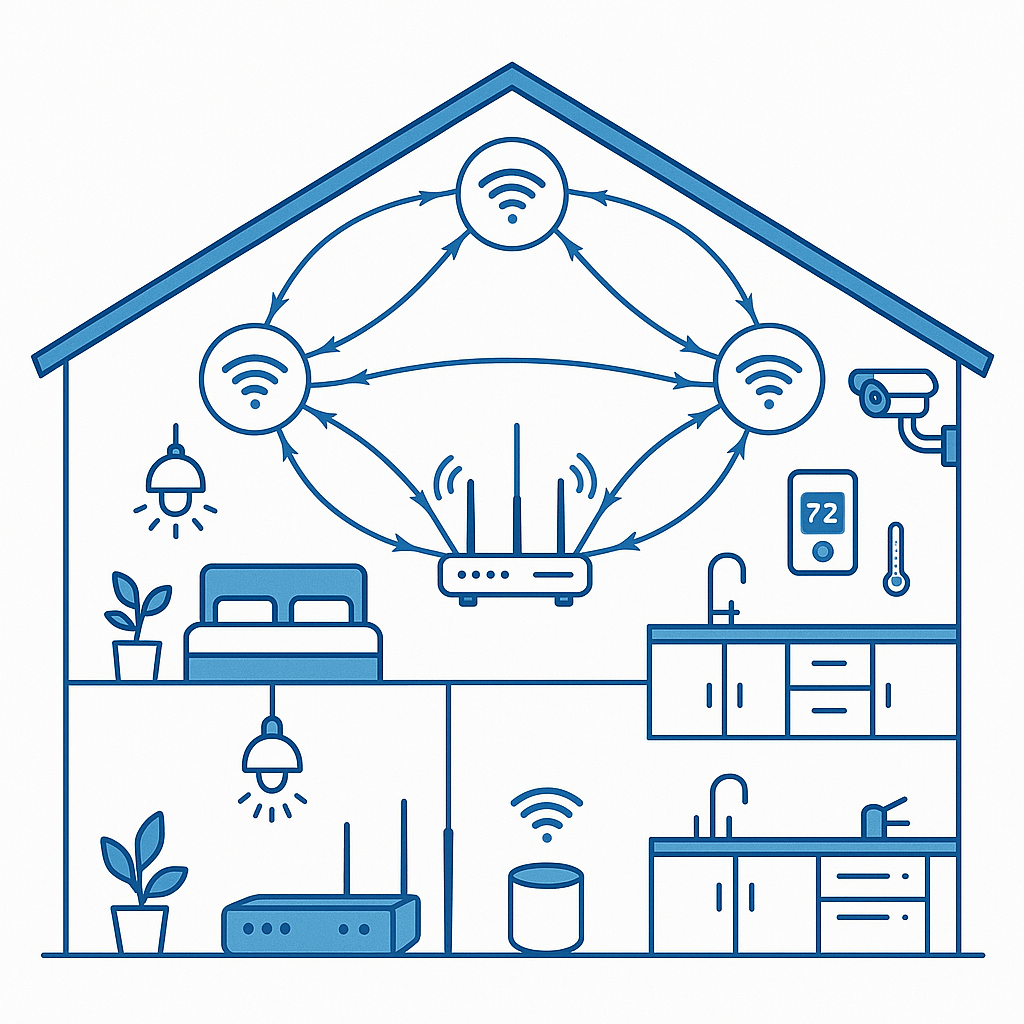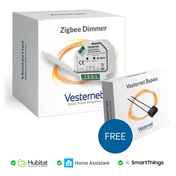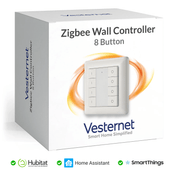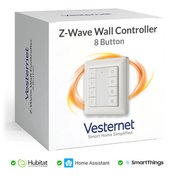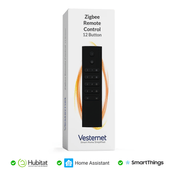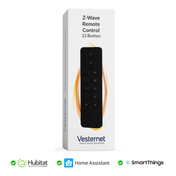Het moderne smart home vertegenwoordigt een samensmelting van gemak, efficiëntie en technologische verfijning die ooit sciencefiction was. Tegenwoordig omarmen huiseigenaren in het Verenigd Koninkrijk intelligente automatiseringssystemen die verlichting, verwarming, beveiliging, entertainment en talloze andere aspecten van het huiselijk leven kunnen regelen. Onder de gestroomlijnde interfaces en intuïtieve bedieningselementen schuilt echter een complexe netwerkinfrastructuur die de basis vormt voor elke smart home-ervaring.
Het creëren van een robuuste draadloze infrastructuur voor je smart home gaat niet alleen over het aanschaffen van de nieuwste gadgets en hopen dat ze naadloos samenwerken. Het vereist zorgvuldige planning, strategisch denken en een grondige kennis van de verschillende technologieën en protocollen die ervoor zorgen dat deze apparaten effectief communiceren. Het verschil tussen een smart home dat je dagelijks leven verbetert en een smart home dat een bron van frustratie wordt, hangt vaak af van de kwaliteit en het ontwerp van de onderliggende netwerkinfrastructuur.
De inzet om dit goed te doen is nog nooit zo hoog geweest. Omdat we steeds meer vertrouwen op slimme huistechnologie voor beveiliging, energiebeheer en dagelijks gemak, kunnen netwerkstoringen reële gevolgen hebben. Een slecht gepland netwerk kan leiden tot beveiligingscamera's die er niet in slagen cruciale beelden op te nemen, verwarmingssystemen die niet reageren op commando's, of verlichtingsregelaars die onvoorspelbaar werken. Bovendien zal, naarmate het aantal verbonden apparaten in een gemiddeld huishouden exponentieel blijft groeien, de druk op uw netwerkinfrastructuur alleen maar toenemen.

Deze uitgebreide gids leidt u door de essentiële overwegingen voor het ontwerpen van een draadloze infrastructuur die niet alleen voldoet aan uw huidige smart home-behoeften, maar ook de schaalbaarheid en betrouwbaarheid biedt die nodig zijn voor toekomstige uitbreiding. We verkennen de basistechnologieën, bekijken de verschillende beschikbare protocollen en bieden praktische richtlijnen voor het creëren van een netwerk dat dient als een solide basis voor uw smart home-ecosysteem.
De basisprincipes van slimme thuisnetwerken begrijpen
De basis van moderne thuisnetwerken
In de kern bouwt elk smart home-netwerk voort op het traditionele TCP/IP-netwerkprotocol dat al tientallen jaren het internet aandrijft. Deze basislaag vormt het basiskader voor apparaatcommunicatie, adressering en gegevensoverdracht waarmee uw smartphones, tablets en computers verbinding kunnen maken met het internet. Inzicht in deze basis is cruciaal, omdat het van invloed is op de manier waarop smart home-apparaten integreren met uw bestaande netwerkinfrastructuur.
De meeste huizen beschikken tegenwoordig al over een basisnetwerkinstallatie bestaande uit een breedbandinternetverbinding, een router (vaak geleverd door de internetprovider) en
Het traditionele thuisnetwerk is primair ontworpen om een beperkt aantal apparaten met hoge bandbreedte te bedienen, zoals computers, smartphones en streamingapparaten. Slimme thuisnetwerken daarentegen moeten tientallen of zelfs honderden verbonden apparaten kunnen bedienen, elk met verschillende bandbreedtevereisten, latentiegevoeligheid en communicatiepatronen. Deze fundamentele verschuiving in netwerkgebruikspatronen vereist een andere aanpak van netwerkontwerp en -beheer.
Overwegingen met betrekking tot netwerktopologie en architectuur
De architectuur van uw slimme thuisnetwerk heeft een grote invloed op de prestaties, betrouwbaarheid en schaalbaarheid ervan.Traditionele stertopologienetwerken, waarbij alle apparaten rechtstreeks verbinding maken met een centrale router, kunnen overbelast raken bij de ondersteuning van meerdere smarthomeapparaten. Deze beperking heeft geleid tot de invoering van mesh-netwerkarchitecturen die de netwerkbelasting verdelen over meerdere toegangspunten, waardoor redundante paden voor gegevensoverdracht ontstaan.
Mesh-netwerken bieden verschillende voordelen voor smart home-toepassingen. Ze bieden een betere dekking in het hele huis, elimineren dode zones die apparaten kunnen belemmeren om betrouwbaar verbinding te maken, en bieden automatische failover-mogelijkheden wanneer individuele netwerkknooppunten problemen ondervinden. Bovendien kunnen mesh-systemen datapaden dynamisch optimaliseren, zodat elk apparaat verbinding maakt via de meest efficiënte route die beschikbaar is.
Mesh-netwerken brengen echter ook complexiteit met zich mee wat betreft configuratie en beheer. Begrijpen hoe apparaten door uw huis worden verdeeld, het identificeren van potentiële storingsbronnen en het plannen van toekomstige uitbreidingen zijn allemaal cruciale overwegingen bij het ontwerpen van een mesh-gebaseerd smart homenetwerk. De plaatsing van mesh-knooppunten, de selectie van geschikte hardware en de configuratie van netwerkinstellingen vereisen allemaal zorgvuldige aandacht om optimale prestaties te garanderen.
Draadloze technologieën en protocolselectie
Wi-Fi : De ruggengraat van moderne slimme huizen
De introductie van de 6 GHz-band in
Inzicht in de frequentiekarakteristieken van verschillende
Gespecialiseerde Smart Home-protocollen
Terwijl

De
De
Opkomende protocollen: Thread en Matter
Thread vertegenwoordigt een nieuwere benadering van smart home-netwerken die de voordelen van IP-gebaseerde communicatie combineert met de energiezuinige eigenschappen die nodig zijn voor apparaten op batterijen. Ontwikkeld door de Thread Group, waartoe grote technologiebedrijven behoren zoals
Het Thread-protocol biedt verschillende voordelen ten opzichte van traditionele smarthomeprotocollen. Door gebruik te maken van IPv6-adressering zijn protocolvertaalgateways niet meer nodig, wat de netwerkarchitectuur vereenvoudigt en potentiële faalpunten vermindert. Thread-netwerken zijn zelfvormend en zelfherstellend, stellen automatisch optimale communicatiepaden vast en passen zich aan veranderingen in de netwerktopologie aan. Het beveiligingsmodel van het protocol omvat end-to-end encryptie en authenticatie, wat robuuste bescherming biedt tegen ongeautoriseerde toegang.
De implementatie van
Netwerkinfrastructuurplanning en -ontwerp
Uw huidige netwerkcapaciteiten beoordelen
Voordat u smart home-apparaten implementeert, is een grondige evaluatie van uw bestaande netwerkinfrastructuur essentieel. Deze evaluatie moet zowel de hardwaremogelijkheden als de prestatiekenmerken van uw huidige configuratie onderzoeken om mogelijke beperkingen en upgradevereisten te identificeren.
Begin met het evalueren van de verbinding van uw internetprovider. Smart home-apparaten vereisen doorgaans een beperkte bandbreedte per apparaat, maar het cumulatieve effect van tientallen aangesloten apparaten kan ontoereikende internetverbindingen overbelasten. Houd rekening met zowel download- als uploadsnelheden, aangezien veel smart home-apparaten bidirectionele communicatie vereisen voor een optimale werking. Cloudgebaseerde services, externe bewaking en videostreamingmogelijkheden zijn allemaal afhankelijk van voldoende uploadbandbreedte.
Uw router vormt de centrale hub van uw netwerkinfrastructuur en heeft een aanzienlijke impact op de algehele prestaties. Oudere routers missen mogelijk de verwerkingskracht, het geheugen en de draadloze mogelijkheden die nodig zijn om talloze smart home-apparaten effectief te ondersteunen. Evalueer de specificaties van uw router ten opzichte van de eisen van uw geplande smart home-implementatie, rekening houdend met factoren zoals het maximale aantal gelijktijdige verbindingen, ondersteunde draadloze standaarden en beschikbare beveiligingsfuncties.
Netwerkdekking in uw hele huis is een andere belangrijke overweging. Smart home-apparaten zijn meestal verspreid over het hele huis, inclusief gebieden die in het verleden mogelijk beperkte netwerkaandacht kregen, zoals kelders, garages en buitenruimtes. Voer een uitgebreid locatieonderzoek uit om gebieden met een zwakke of inconsistente draadloze dekking te identificeren die een betrouwbare werking van smart home-apparaten kunnen belemmeren.
Overwegingen met betrekking tot capaciteitsplanning en schaalbaarheid
Een effectieve planning van een smart home-netwerk vereist een zorgvuldige afweging van zowel de huidige vereisten als toekomstige uitbreidingsmogelijkheden. Het aantal verbonden apparaten in smart homes blijft snel groeien en uw netwerkinfrastructuur moet deze groei kunnen opvangen zonder dat de prestaties achteruitgaan.
Maak een schatting van het totale aantal apparaten dat u in eerste instantie wilt aansluiten en voorspel de toekomstige uitbreiding over een periode van drie tot vijf jaar. Houd hierbij niet alleen rekening met voor de hand liggende apparaten zoals slimme schakelaars En thermostaten maar ook minder zichtbare verbonden apparaten zoals sensoren, beveiligingssystemen en entertainmentapparatuur. Elke apparaatcategorie heeft verschillende bandbreedtevereisten, latentiegevoeligheid en communicatiepatronen die van invloed zijn op het algehele netwerkontwerp.
Bandbreedteplanning vereist inzicht in zowel de individuele vereisten van elk apparaattype als de totale vraag naar uw netwerkinfrastructuur. Hoewel individuele smarthomeapparaten doorgaans minimale bandbreedte verbruiken, kan het cumulatieve effect van meerdere apparaten aanzienlijk zijn, vooral tijdens piekuren of wanneer meerdere apparaten tegelijkertijd worden bijgewerkt.
Configuratie van Quality of Service (QoS) wordt steeds belangrijker naarmate het aantal verbonden apparaten toeneemt. Het prioriteren van verkeer van kritieke apparaten zoals beveiligingscamera's En rookmelders Zorgt ervoor dat deze essentiële diensten een betrouwbare verbinding behouden, zelfs tijdens periodes van netwerkcongestie. Evenzo kan bandbreedtetoewijzing voor entertainmentapparatuur voorkomen dat streamingactiviteiten de domoticafuncties verstoren.
Beveiligingsarchitectuur en implementatie
Beveiligingsoverwegingen moeten in elk aspect van het ontwerp van een smart home-netwerk worden geïntegreerd en niet als een bijzaak worden beschouwd. De gedistribueerde aard van smart home-apparaten creëert talloze potentiële toegangspunten voor kwaadwillenden, waardoor een uitgebreide beveiligingsplanning essentieel is om zowel uw netwerk als uw privacy te beschermen.
Netwerksegmentatie is een van de meest effectieve beveiligingsstrategieën voor smarthomenetwerken. Door smarthomeapparaten te isoleren in afzonderlijke netwerksegmenten of VLAN's, kunt u de potentiële impact van gecompromitteerde apparaten beperken en ongeautoriseerde toegang tot gevoelige systemen zoals computers en netwerkopslagapparaten voorkomen. Deze segmentatie kan worden geïmplementeerd via beheerde switches, geavanceerde routers of speciale beveiligingsapparaten.
Apparaatauthenticatie en toegangscontrolemechanismen zorgen ervoor dat alleen geautoriseerde apparaten verbinding kunnen maken met uw netwerk. Implementeer sterke, unieke wachtwoorden voor alle netwerktoegangspunten en overweeg certificaatgebaseerde authenticatie voor verbeterde beveiliging. Regelmatige wachtwoordupdates en het verwijderen van standaardreferenties zijn essentiële praktijken voor het handhaven van de netwerkbeveiliging.
Versleutelingsprotocollen beschermen de gegevensoverdracht tussen apparaten en voorkomen afluisteren van netwerkcommunicatie. Zorg ervoor dat alle draadloze netwerken WPA3-versleuteling gebruiken waar ondersteund, of WPA2 als minimale standaard. Vermijd WEP-versleuteling volledig, aangezien deze onvoldoende bescherming biedt tegen moderne aanvalsmethoden.
Implementatiestrategieën en best practices
Gefaseerde implementatieaanpak
De implementatie van een uitgebreid smart home-netwerk kunt u het beste gefaseerd aanpakken in plaats van te proberen alle apparaten tegelijk te implementeren. Deze gefaseerde aanpak stelt u in staat de netwerkprestaties te valideren, potentiële problemen te identificeren en uw configuratie te verfijnen voordat u extra complexiteit toevoegt.
Begin met de belangrijkste infrastructuurcomponenten, zoals uw router, toegangspunten en alle benodigde knooppunten of gateways. Zorg ervoor dat deze basiselementen correct geconfigureerd zijn en optimaal presteren voordat u smarthome-apparaten toevoegt. Met deze aanpak kunt u basisprestatiegegevens vaststellen en eventuele infrastructuurbeperkingen identificeren die de werking van het apparaat kunnen beïnvloeden.
De eerste fase van de implementatie van het apparaat moet zich richten op essentiële systemen zoals beveiligingsapparaten, rookmelders, en kritisch verlichtingsregelaarsDeze apparaten bieden directe veiligheids- en beveiligingsvoordelen en stellen u in staat ervaring op te doen met het beheer en de probleemoplossing van slimme apparaten voor thuisgebruik. Monitor de netwerkprestaties tijdens deze eerste implementatie om er zeker van te zijn dat uw infrastructuur de extra belasting aankan.
Vervolgende fasen kunnen gemaks- en efficiëntie-apparaten introduceren, zoals slimme thermostaten, TRV-regelaarsen extra verlichtingsregelaars. Deze geleidelijke uitbreiding stelt u in staat de impact van elke apparaatcategorie op de netwerkprestaties te beoordelen en indien nodig aanpassingen te doen.
Overwegingen bij apparaatselectie en protocol
Bij het selecteren van slimme apparaten voor thuisgebruik voor uw netwerk moeten protocolcompatibiliteit en ecosysteemintegratie de belangrijkste overwegingen zijn.
Voor toepassingen met lichtregeling kunt u het volgende overwegen:
Temperatuurregeling vertegenwoordigt een ander belangrijk toepassingsgebied waarbij protocolselectie van invloed is op de prestaties.

Monitoring- en onderhoudsprocedures
Continue monitoring en onderhoud zijn essentieel om de betrouwbaarheid en prestaties van uw smart home-netwerk op lange termijn te garanderen. Stel regelmatig procedures in voor het beoordelen van de netwerkstatus, het updaten van de firmware van apparaten en het verhelpen van mogelijke beveiligingsproblemen.
Netwerkmonitoringtools kunnen waardevolle inzichten bieden in de prestaties van apparaten, bandbreedtegebruik en mogelijke verbindingsproblemen. Veel moderne routers beschikken over ingebouwde monitoringmogelijkheden, terwijl speciale netwerkmonitoringoplossingen uitgebreidere analyse- en waarschuwingsmogelijkheden bieden. Regelmatige controle van deze meetgegevens kan helpen trends en potentiële problemen te identificeren voordat ze de werking van het systeem beïnvloeden.
Firmware-updates vormen een cruciaal aspect van het onderhoud van smarthome-apparaten. Fabrikanten brengen regelmatig updates uit die beveiligingsproblemen verhelpen, de prestaties verbeteren en nieuwe functies toevoegen. Stel procedures vast voor het regelmatig controleren en uitvoeren van firmware-updates op alle aangesloten apparaten, waarbij prioriteit wordt gegeven aan beveiligingsgerelateerde updates.
Documentatie van uw netwerkconfiguratie, apparaatinventaris en probleemoplossingsprocedures vergemakkelijkt doorlopend onderhoud en helpt problemen efficiënter op te lossen. Houd gegevens bij van apparaatlocaties, netwerkconfiguraties en eventuele aanpassingen of speciale instellingen die nodig zijn voor een goede werking.
Geavanceerde netwerkoptimalisatie
Mesh-netwerkontwerp en -optimalisatie
Voor grotere huizen of uitdagende RF-omgevingen is het ontwerp van een mesh-netwerk essentieel om een betrouwbare werking van slimme apparaten voor thuisgebruik te garanderen.
Strategische plaatsing van apparaten op netstroom Door uw hele huis creëert een robuuste mesh-infrastructuur die op batterijen werkende sensoren en controllers ondersteunt. Deze apparaten fungeren als repeaters, waardoor het netwerkbereik wordt vergroot en de algehele betrouwbaarheid wordt verbeterd. Denk na over de plaatsing van slimme stekkers En inbouwmodules om een optimale mesh-topologie te creëren.
Netwerkherstel- en optimalisatieprocedures moeten regelmatig worden uitgevoerd om optimale routeringspaden te garanderen. De meeste
Integratie met domoticaplatforms
Moderne smart home-netwerken profiteren van de integratie met uitgebreide domoticaplatforms die gecentraliseerde controle en geavanceerde automatiseringsmogelijkheden bieden.Deze platforms kunnen activiteiten over meerdere apparaattypen en protocollen coördineren en zo geavanceerde automatiseringsscenario's creëren die het comfort, de beveiliging en de energie-efficiëntie verbeteren.
Overweeg platforms die meerdere protocollen tegelijkertijd ondersteunen, zodat u de sterke punten van verschillende technologieën binnen één ecosysteem kunt benutten. Deze aanpak biedt flexibiliteit bij de apparaatselectie, terwijl uniforme controle- en automatiseringsmogelijkheden behouden blijven.
Geavanceerde automatiseringsscenario's kunnen coördineren bewegingssensoren, verlichtingsregelaars, En verwarmingssystemen Om responsieve omgevingen te creëren die zich aanpassen aan bezettingspatronen en voorkeuren. Deze integraties tonen de waarde aan van een goed ontworpen netwerkinfrastructuur ter ondersteuning van geavanceerde domoticatoepassingen.
Conclusie
Het ontwerpen van een effectieve draadloze infrastructuur voor uw smart home vereist zorgvuldige planning, strategisch denken en een grondige kennis van de beschikbare technologieën en protocollen. De basis die u vandaag legt, bepaalt niet alleen de prestaties en betrouwbaarheid van uw huidige smart home-apparaten, maar ook uw mogelijkheden om uw systeem in de toekomst uit te breiden en te verbeteren.
De sleutel tot succes ligt in een holistische benadering die rekening houdt met alle aspecten van netwerkontwerp, van de onderliggende infrastructuur en protocolselectie tot de implementatie van beveiliging en continu onderhoud. Door de sterke en zwakke punten van verschillende technologieën te begrijpen, schaalbaarheid te plannen en robuuste beveiligingsmaatregelen te implementeren, kunt u een netwerkinfrastructuur creëren die een solide basis vormt voor uw intelligente thuisomgeving.
Naarmate de technologie voor slimme huizen zich blijft ontwikkelen en er nieuwe protocollen komen, zoals
Onthoud dat het plannen van een smart home-netwerk geen eenmalige activiteit is, maar een continu proces dat regelmatig moet worden beoordeeld en aangepast naarmate uw behoeften evolueren en nieuwe technologieën beschikbaar komen. Door op de hoogte te blijven van opkomende trends en een proactieve aanpak van netwerkbeheer te hanteren, kunt u ervoor zorgen dat uw smart home-infrastructuur de komende jaren aan uw behoeften blijft voldoen.

